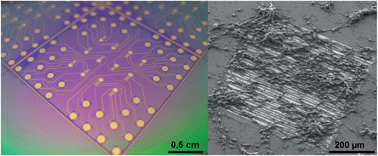Researchers have adapted a gold electrode to enhance electrochemical dopamine measurements and overcome the fouling problems that typically occur on the surface when using this technique.

Cells on doped overoxidised PPy modified electrodes
Many diseases such as Parkinson’s and schizophrenia are caused by irregularities in the neurotransmitter dopamine. Each disease affects dopamine production differently, however in all cases studying the process both inside and outside the body has presented many challenges.
Jenny Emnéus at the Technical University of Denmark and collaborators in Italy improved the detection of dopamine by placing a doped overoxidised polypyrrole (PPy) film on the electrode surface. The film was doped with different counter ions to inhibit dopamine polymerisation and the binding of negatively charged species. Although the overoxidation of PPy did affect the conductivity of the film, it also became more sensitive to dopamine, suggesting that doped overoxidised PPy can be used as sensors for dopamine.
To learn more about the techniques the authors used to reduce surface fouling and detect dopamine release from live cells, check out the article below. It will be free to read until May 28th .
Doped overoxidized polypyrrole microelectrodes as sensors for the detection of dopamine released from cell populations
Luigi Sasso, Arto Heiskanen, Francesco Diazzi, Maria Dimaki, Jaime Castillo-León, Marco Vergani, Ettore Landini, Roberto Raiteri, Giorgio Ferrari, Marco Carminati, Marco Sampietro, Winnie E. Svendsen and Jenny Emnéus
Analyst, 2013, Advance Article
DOI: 10.1039/C3AN00085K










